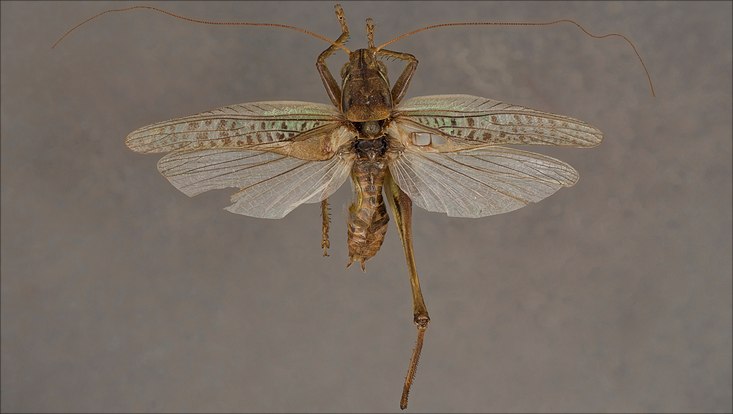Treasure of the Month: Gampsocleis glabra

© Thure Dalsgaard
In the 20th century, our treasure of the month was already considered extinct in many regions: Only in the Klietzer (Saxony-Anhalt) and Lüneburger Heide did small populations survive on military training and shooting ranges. A team of LIB researchers led by Martin Husemann and Oliver Hawlitschek have been researching the species, which is rare in Germany, in more detail: they want to find out how great the genetic diversity of the native Gampsocleis glabra currently is and whether its biodiversity has declined over the years due to the local extinction of many populations.
It lays its eggs in places on the ground with weak vegetation. Their larvae hatch from mid-April and go through six different stages in their development. Only the males have organs with which they can produce the typical scare song. The adult grasshopper, up to 27 millimetres long, is also found outside Germany in the region between the Caspian and Black Seas. In this country, it is classified on the Red List as threatened with extinction.
The name already suggests it: Our Treasure of the Month inhabits dry-warm heath areas that offer them both open ground to bask on and tall grasses to sing on. Such areas are becoming increasingly rare in Germany, however, because they are either intensively farmed or afforested.
Curiously, the last known occurrences of heath grasshoppers in our country are on military security areas – for example near Munster in the Lüneburg Heath. Here, the animals benefit from the activities of soldiers who burn down parts of the vegetation during their weapons training: in doing so, they damage the moss carpet of the soil and thus create new areas for the grasshoppers to lay their eggs.
The genetic studies on our treasure help to determine how diverse the indigenous populations of the Gampsocleis glabra still are in Germany. For this purpose, a team of researchers led by Martin Husemann, head of the Hemimetabola & Hymenoptera Section, takes DNA samples from populations that still exist and compares their composition with that of older animals in our scientific collections.
The samples are analysed in our molecular laboratory under the direction of Oliver Hawlitschek using state-of-the-art genomic methods. The data collected helps to assess how much the individual, still existing populations differ genetically in order to derive important information for breeding programmes.


